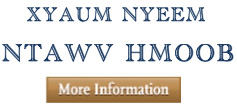History in China
IN THIS SECTION
To Tell the Truth
By Jacques Lemoine, Ph.D.
Hmong Studies Journal, Volume 9, 29 Pages
Abstract
This paper is inspired by the reading of Dr. Lee’s article in Hmong Studies Journal, Vol. 8: “Diaspora and the Predicament of Origins: Interrogating Hmong Postcolonial History and Identity†and my recent, albeit too short visit to Minnesota in order to receive my Eagle Award in Hmong Studies and participate in the Center for Hmong Studies’ Conference: “Cultivating the Past, Interpreting the Present, and Enriching the Futureâ€, at Concordia University, Saint Paul (April 12, 2008). There I met three fascinating Miao scholars from China.1 There was some confrontation in our respective approach to (H)mong2 studies from opposite viewpoints: their, the Miao imagined nation, mine, the (H)mong transnational ethnic group. Once more, I have the feeling that it is the duty of a scholar of my generation to see that (H)mong studies avoid the political and scholastic fantasies of the time, and keep progressing in the only right direction: scientific knowledge. I deal here with three issues: a) the recent development of (H)mong studies in China, b) the content and meaning of a so-called “Hmong/Miao transnationalityâ€, c) the faithfulness to (H)mong culture.
A. (H)mong Studies in China:
I have followed (H)mong studies in China for the past 40 years and my personal data collection on Chinese Minority Nationalities [including the (H)mong and the Miao] is quite comprehensive up to the end of the past millennium, but I must confess that the picture of the written resources on the (H)mong in China is changing. When, before, field studies were mostly collected in the volumes Reports on the Investigation Data on Miao Nationality’s Social History3, a series encompassing all the Minority Nationalities of China, recent research is now published in books. And these books generally printed in small number (on the Chinese scale) are difficult to find outside the very province they have been published. Needless to say, Guizhou and Yunnan are the most likely places where to find those books. Unfortunately, they hardly transit from one province to another or to Beijing, Guangdong or Hong Kong, the book business in China remaining mostly labyrinthine.4 This is why it is so helpful that Hmong travelers in China collect as many books about the Miao as possible and that copies of these books may find their way to the Hmong Archives in Saint Paul, or/and in the Hmong Cultural Center Resource Library, also in Saint Paul (MN).
After the language barrier, the main problem in using Chinese studies is to distinguish what concerns specifically the (H)mong amidst the already huge literature on the Miao nationality. In Investigation Data the local ethnic name of the concerned Miao group is usually mentioned and this is very precious because since the creation of the Miao nationality in 1953 all of the local ethnic designations have been blurred in published material in order to show the “unity†of the Miao nationality. I think I was the first (in an appendix to my 1968 thesis5) to point out the three main Miao languages [(H)mong, Hmu, Kexiong or Qho Xiong] corresponding more or less to the same number of what we usually call “ethnic groupsâ€.6 Later on, in 1985, visiting some of their villages in Yunnan, I identified the A Hmao, or Da Hua Miao, hidden under their linguistic classification as the “Eastern Yunnan sub-dialect of the Chuantiandian dialect [i.e. (H)mong] of Miao languageâ€. More recently, the Ge or Ge Hmon, have made their way to the media and at least to one anthropologist in order to sustain their claim not to be classified as Miao.
READ FULL ARTICLE FROM HMONG STUDIES JOURNAL







